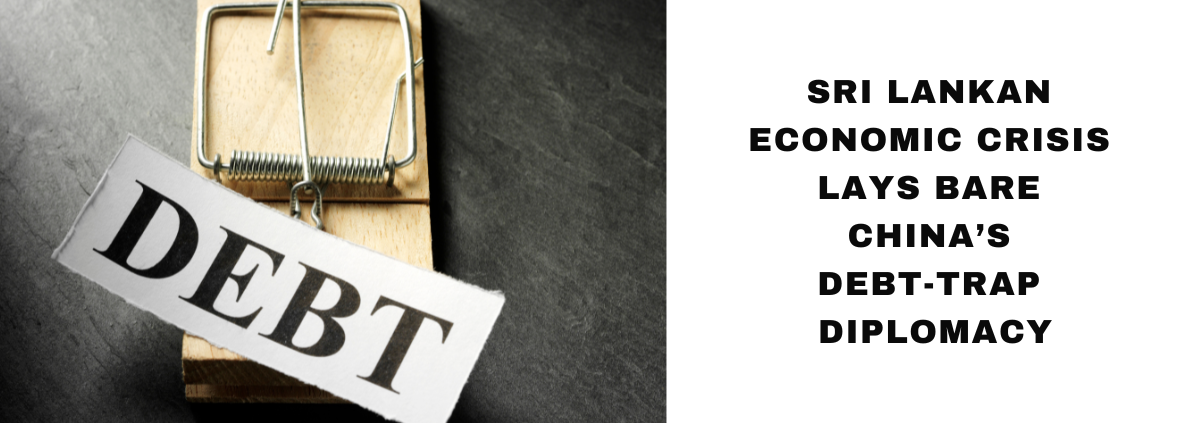As I write this, Sri Lanka’s foreign reserves have depleted to $50 million, in what can be deemed as a harrowing economic crisis. Parts of the country are facing prolonged power outages, people are protesting on the streets, the military has been deployed, and the Government expects the status quo to continue for at least two more years. However, if history is any indication, such crises can often snowball into utter ruination. Many tell-tale signs are hinting at worse times ahead: No-confidence motion has been tabled, people are making desperate attempts to flee the country, etc. So, what led to the downfall of a country whose per capita income was $3,619 in 2012 — the highest in South Asia at the time?
There is no single answer to this question; it was a combination of poor economic policies, the pandemic, and the Easter attack, among other misfortunes. However, there is a less-talked-about cause behind Sri Lanka’s current predicament: Debt-trap diplomacy. This is a foreign-policy instrument, wherein a rich country enters into an agreement with a development-driven poorer country — which is often resource-rich and geopolitically advantageous — for debt funding, to gain geopolitical leverage or annex key assets when the debts become unsustainable as intended. At a time when the scope for kinetic warfare and expansionism is rather limited, countries resort to means like debt-trap diplomacy. For Sri Lanka’s part, debt-trap diplomacy can be attributed to its association with China.
How deep is the debt-trap diplomacy?
During the civil war that ended in 2009, China increased its leverage on Sri Lanka by supplying arms. This is how debt-trap diplomacy is initiated — by creating an obligation on part of the receiver. This was followed by FDIs and assistance in international affairs. China has wielded its veto power at the UN to safeguard Sri Lanka’s interests on more than one occasion. This was around the time when China was supercharging its BRI ambitions and “String of Pearls” strategy, which have a strong anti-India focus. Sri Lanka, Pakistan, and Nepal’s geographical proximity to India made them ideal for China’s debt-trap diplomacy. Anyone with a modicum of knowledge of China’s ways will attest that there are no other cultural or traditional incentives for China to support these nations.
China has since disbursed in the excess of $10 billion to Sri Lanka. The latter has lost key assets due to defaulting. Hambantota port, for example, was to be a billion-dollar, Chinese-funded project. However, owing to debts, it is now leased to China for 99 years. It is common knowledge that there are more such cases and “hidden” loans across the world. According to a study(1), China has disbursed approximately $385-billion worth of “unreported” loans, across over 40 economically fragile nations. Around 42 nations have a public-debt exposure to China in excess of 10% of their GDPs. Many debts are unreported/underreported because central government institutions in low-income countries are not often the primary borrowers responsible for repayment, the study reveals.
The eventuality
Once a beneficiary accrues debts and fails to generate returns from investments made using the loaned capital, it sets off an adverse chain reaction, ultimately leading to utter ruination. I believe this is the eventuality facing the victims of the debt-trap diplomacy of China. Laos, Kyrgyzstan, and Zambia’s public debt exposure to China is now more than 20% of their respective GDPs. Laos has already lost a key electrical infrastructure to China as part of the debt relief. Nations like Pakistan and Nepal are heading in a similar direction, with depleting foreign reserves, political instabilities, and mounting debts. About time these nations, and leading economies across the world, acknowledge the cost-of-doing-business with China.
According to World Bank estimates, 500,000 people in Sri Lanka have fallen into poverty in the past couple of years. Sri Lanka’s economic future now lies at the hands of the UN institutions like the IMF and World Bank. The island nation has requested bailouts, and the IMF has given a green signal to restructure the debts. Sri Lanka’s request for debt relief has not elicited an answer in the affirmative from China, yet. This goes on to show that the relationship between Sri Lanka and China was not forged on comradery but on the latter’s geopolitical interests and the former’s financial desperation. It’s refreshing, though, to see Sri Lankan citizens wake up to China’s devious designs. Many are calling out leaders(2) for enabling China’s debt-trap diplomacy. I believe that as long as the lessons are not lost on the masses, there is still hope.
- https://www.aiddata.org/blog/aiddatas-new-dataset-of-13-427-chinese-development-projects-worth-843-billion-reveals-major-increase-in-hidden-debt-and-belt-and-road-initiative-implementation-problems
- https://www.ndtv.com/world-news/sold-everything-to-china-sri-lankan-traders-to-embattled-pm-2864111



